Healthcare Economics Report: ACA Reform Impacts (2011-2014)
VerifiedAdded on 2023/06/08
|9
|2081
|308
Report
AI Summary
This report provides an analysis of the economic impact of the Affordable Care Act (ACA), also known as Obamacare, from 2011 to 2014. The report examines the ACA's three fundamental goals: expanding health insurance coverage, expanding Medicaid, and improving healthcare delivery methods. It details the various initiatives of the ACA, including insurance coverage, insurance providers, and reimbursements. The report explores the economic impacts of the ACA during the specified period, including increased insurance subscriptions, reduced private sector market share, changes in payment methods, and improvements in care quality, while also considering other impacts like improved care quality and reduced costs, and increased access to care. The report concludes with an opinion on the ACA reforms, highlighting their positive effects on healthcare access and affordability for a wider population, and acknowledges potential challenges from alternative programs.
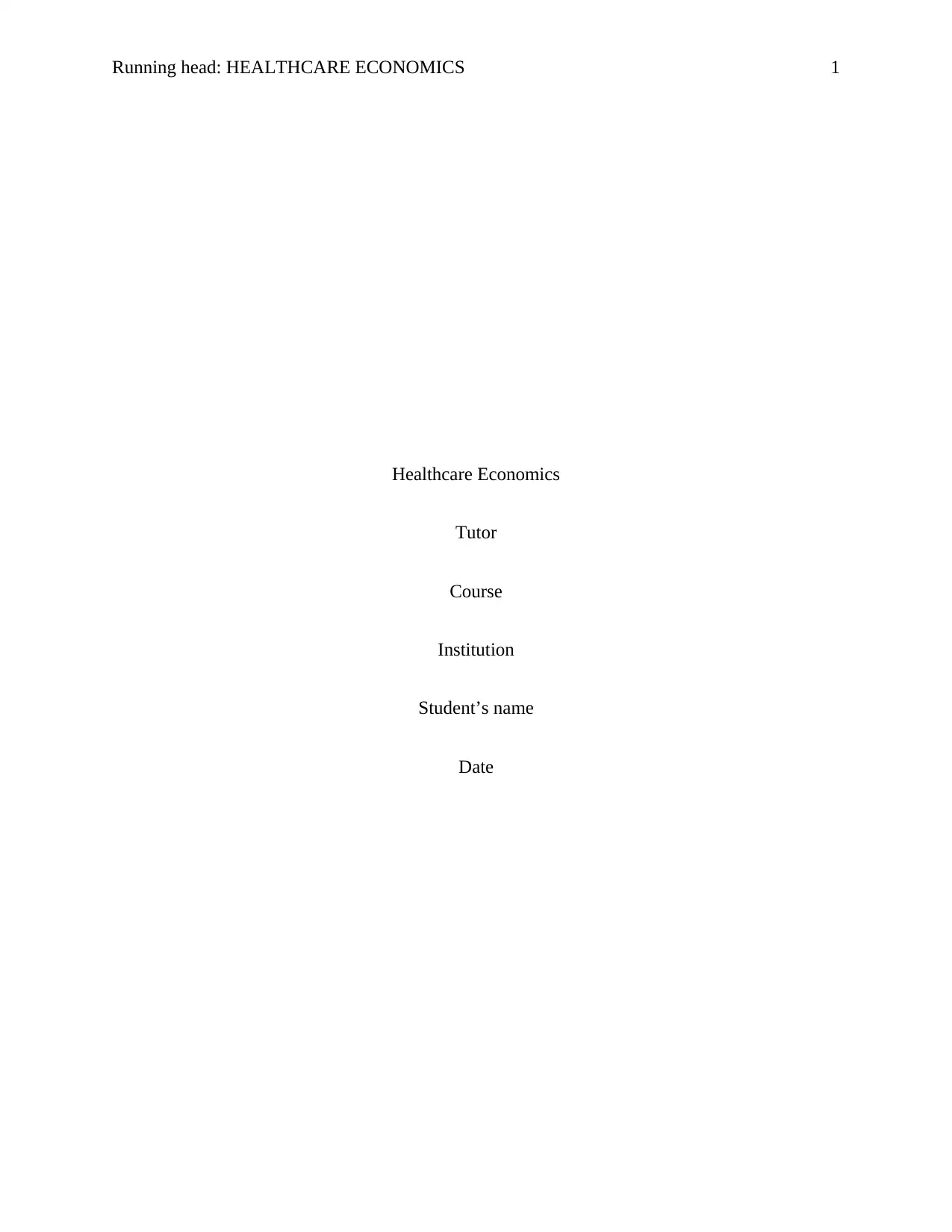
Running head: HEALTHCARE ECONOMICS 1
Healthcare Economics
Tutor
Course
Institution
Student’s name
Date
Healthcare Economics
Tutor
Course
Institution
Student’s name
Date
Paraphrase This Document
Need a fresh take? Get an instant paraphrase of this document with our AI Paraphraser
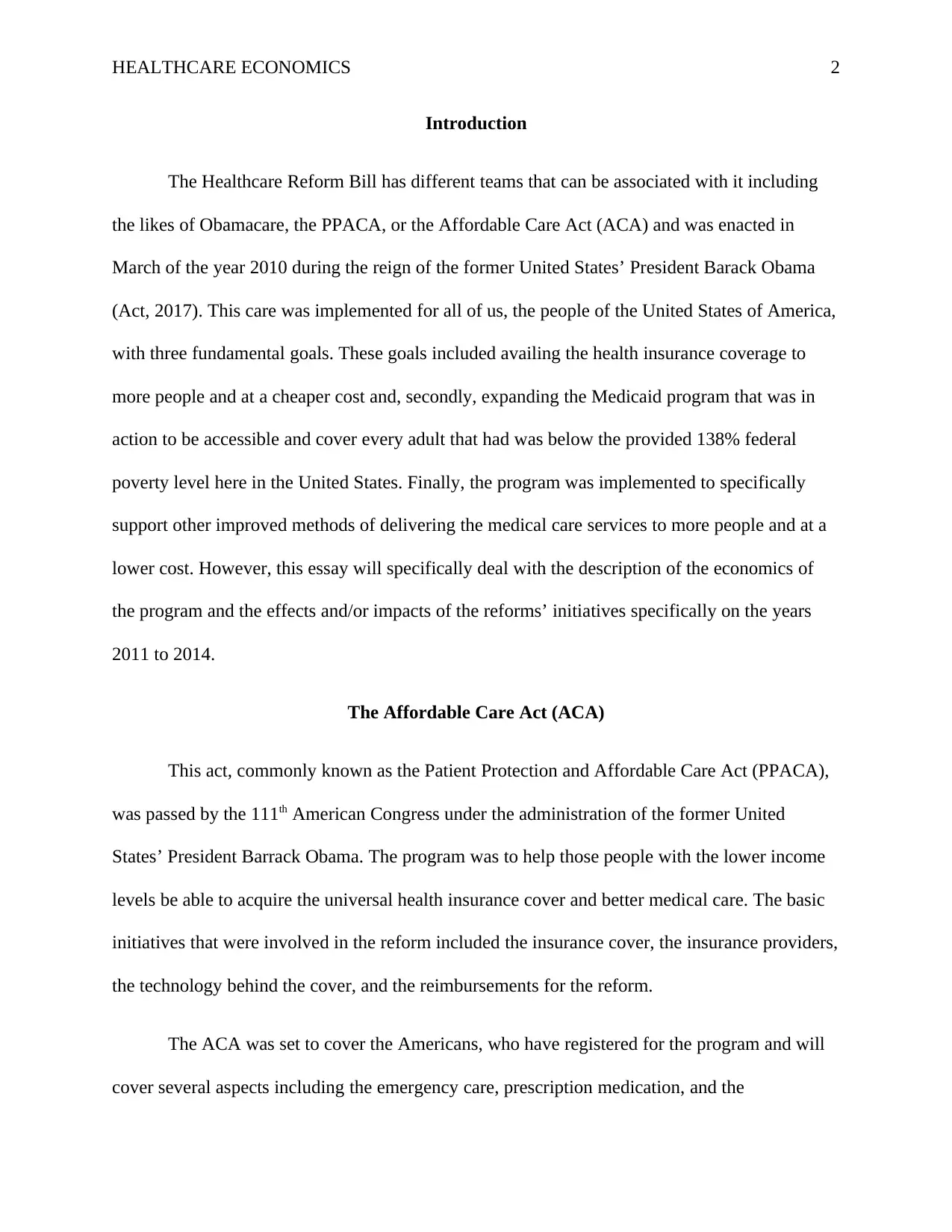
HEALTHCARE ECONOMICS 2
Introduction
The Healthcare Reform Bill has different teams that can be associated with it including
the likes of Obamacare, the PPACA, or the Affordable Care Act (ACA) and was enacted in
March of the year 2010 during the reign of the former United States’ President Barack Obama
(Act, 2017). This care was implemented for all of us, the people of the United States of America,
with three fundamental goals. These goals included availing the health insurance coverage to
more people and at a cheaper cost and, secondly, expanding the Medicaid program that was in
action to be accessible and cover every adult that had was below the provided 138% federal
poverty level here in the United States. Finally, the program was implemented to specifically
support other improved methods of delivering the medical care services to more people and at a
lower cost. However, this essay will specifically deal with the description of the economics of
the program and the effects and/or impacts of the reforms’ initiatives specifically on the years
2011 to 2014.
The Affordable Care Act (ACA)
This act, commonly known as the Patient Protection and Affordable Care Act (PPACA),
was passed by the 111th American Congress under the administration of the former United
States’ President Barrack Obama. The program was to help those people with the lower income
levels be able to acquire the universal health insurance cover and better medical care. The basic
initiatives that were involved in the reform included the insurance cover, the insurance providers,
the technology behind the cover, and the reimbursements for the reform.
The ACA was set to cover the Americans, who have registered for the program and will
cover several aspects including the emergency care, prescription medication, and the
Introduction
The Healthcare Reform Bill has different teams that can be associated with it including
the likes of Obamacare, the PPACA, or the Affordable Care Act (ACA) and was enacted in
March of the year 2010 during the reign of the former United States’ President Barack Obama
(Act, 2017). This care was implemented for all of us, the people of the United States of America,
with three fundamental goals. These goals included availing the health insurance coverage to
more people and at a cheaper cost and, secondly, expanding the Medicaid program that was in
action to be accessible and cover every adult that had was below the provided 138% federal
poverty level here in the United States. Finally, the program was implemented to specifically
support other improved methods of delivering the medical care services to more people and at a
lower cost. However, this essay will specifically deal with the description of the economics of
the program and the effects and/or impacts of the reforms’ initiatives specifically on the years
2011 to 2014.
The Affordable Care Act (ACA)
This act, commonly known as the Patient Protection and Affordable Care Act (PPACA),
was passed by the 111th American Congress under the administration of the former United
States’ President Barrack Obama. The program was to help those people with the lower income
levels be able to acquire the universal health insurance cover and better medical care. The basic
initiatives that were involved in the reform included the insurance cover, the insurance providers,
the technology behind the cover, and the reimbursements for the reform.
The ACA was set to cover the Americans, who have registered for the program and will
cover several aspects including the emergency care, prescription medication, and the
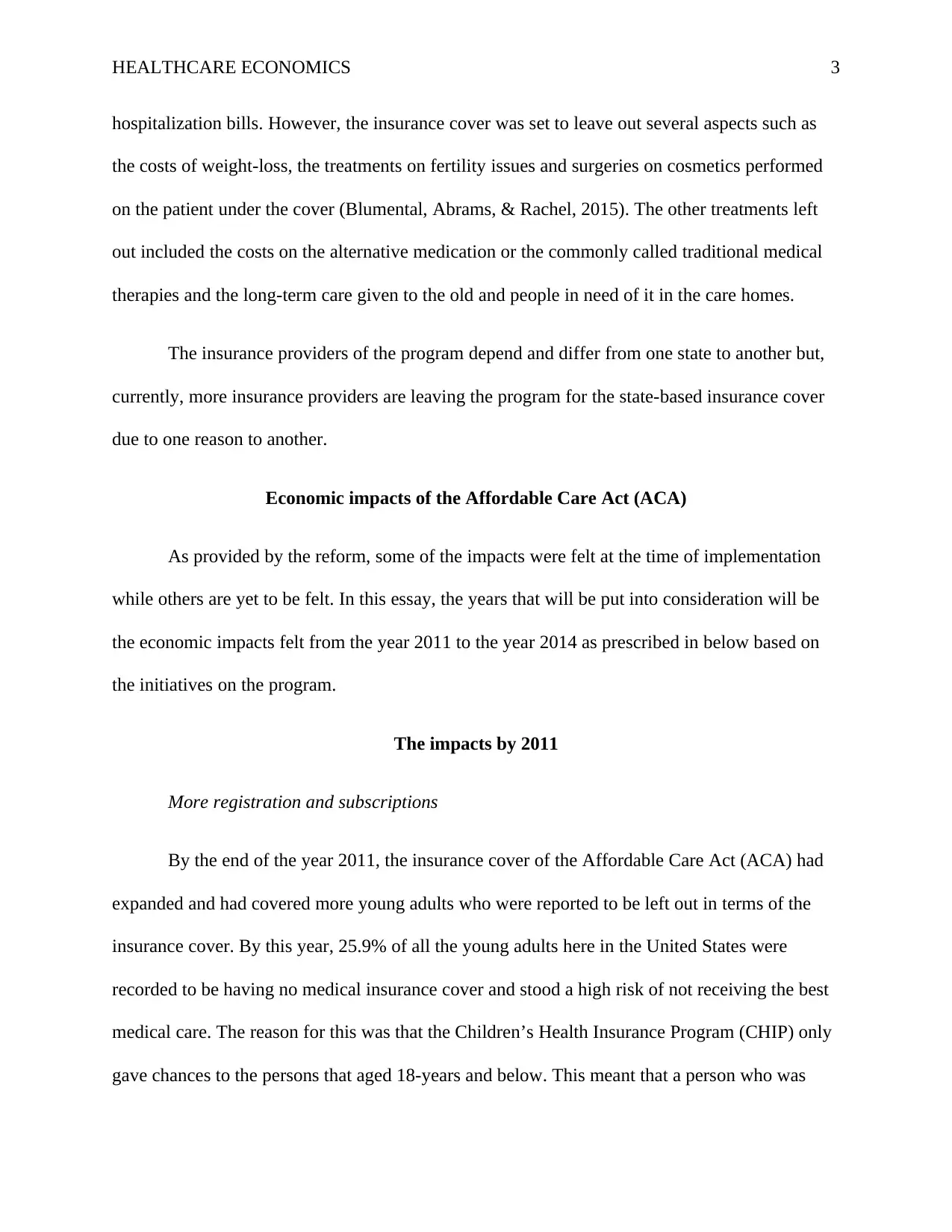
HEALTHCARE ECONOMICS 3
hospitalization bills. However, the insurance cover was set to leave out several aspects such as
the costs of weight-loss, the treatments on fertility issues and surgeries on cosmetics performed
on the patient under the cover (Blumental, Abrams, & Rachel, 2015). The other treatments left
out included the costs on the alternative medication or the commonly called traditional medical
therapies and the long-term care given to the old and people in need of it in the care homes.
The insurance providers of the program depend and differ from one state to another but,
currently, more insurance providers are leaving the program for the state-based insurance cover
due to one reason to another.
Economic impacts of the Affordable Care Act (ACA)
As provided by the reform, some of the impacts were felt at the time of implementation
while others are yet to be felt. In this essay, the years that will be put into consideration will be
the economic impacts felt from the year 2011 to the year 2014 as prescribed in below based on
the initiatives on the program.
The impacts by 2011
More registration and subscriptions
By the end of the year 2011, the insurance cover of the Affordable Care Act (ACA) had
expanded and had covered more young adults who were reported to be left out in terms of the
insurance cover. By this year, 25.9% of all the young adults here in the United States were
recorded to be having no medical insurance cover and stood a high risk of not receiving the best
medical care. The reason for this was that the Children’s Health Insurance Program (CHIP) only
gave chances to the persons that aged 18-years and below. This meant that a person who was
hospitalization bills. However, the insurance cover was set to leave out several aspects such as
the costs of weight-loss, the treatments on fertility issues and surgeries on cosmetics performed
on the patient under the cover (Blumental, Abrams, & Rachel, 2015). The other treatments left
out included the costs on the alternative medication or the commonly called traditional medical
therapies and the long-term care given to the old and people in need of it in the care homes.
The insurance providers of the program depend and differ from one state to another but,
currently, more insurance providers are leaving the program for the state-based insurance cover
due to one reason to another.
Economic impacts of the Affordable Care Act (ACA)
As provided by the reform, some of the impacts were felt at the time of implementation
while others are yet to be felt. In this essay, the years that will be put into consideration will be
the economic impacts felt from the year 2011 to the year 2014 as prescribed in below based on
the initiatives on the program.
The impacts by 2011
More registration and subscriptions
By the end of the year 2011, the insurance cover of the Affordable Care Act (ACA) had
expanded and had covered more young adults who were reported to be left out in terms of the
insurance cover. By this year, 25.9% of all the young adults here in the United States were
recorded to be having no medical insurance cover and stood a high risk of not receiving the best
medical care. The reason for this was that the Children’s Health Insurance Program (CHIP) only
gave chances to the persons that aged 18-years and below. This meant that a person who was
⊘ This is a preview!⊘
Do you want full access?
Subscribe today to unlock all pages.

Trusted by 1+ million students worldwide
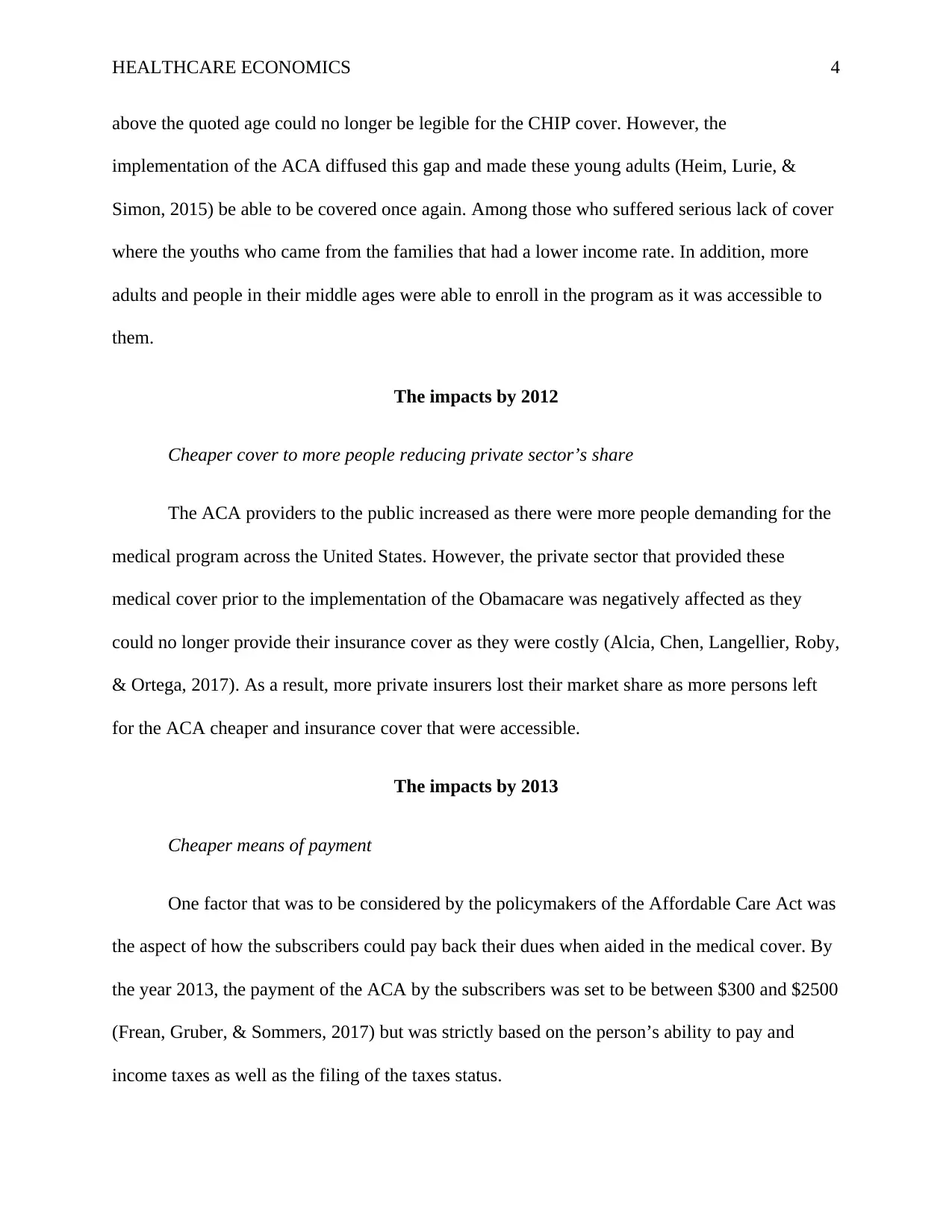
HEALTHCARE ECONOMICS 4
above the quoted age could no longer be legible for the CHIP cover. However, the
implementation of the ACA diffused this gap and made these young adults (Heim, Lurie, &
Simon, 2015) be able to be covered once again. Among those who suffered serious lack of cover
where the youths who came from the families that had a lower income rate. In addition, more
adults and people in their middle ages were able to enroll in the program as it was accessible to
them.
The impacts by 2012
Cheaper cover to more people reducing private sector’s share
The ACA providers to the public increased as there were more people demanding for the
medical program across the United States. However, the private sector that provided these
medical cover prior to the implementation of the Obamacare was negatively affected as they
could no longer provide their insurance cover as they were costly (Alcia, Chen, Langellier, Roby,
& Ortega, 2017). As a result, more private insurers lost their market share as more persons left
for the ACA cheaper and insurance cover that were accessible.
The impacts by 2013
Cheaper means of payment
One factor that was to be considered by the policymakers of the Affordable Care Act was
the aspect of how the subscribers could pay back their dues when aided in the medical cover. By
the year 2013, the payment of the ACA by the subscribers was set to be between $300 and $2500
(Frean, Gruber, & Sommers, 2017) but was strictly based on the person’s ability to pay and
income taxes as well as the filing of the taxes status.
above the quoted age could no longer be legible for the CHIP cover. However, the
implementation of the ACA diffused this gap and made these young adults (Heim, Lurie, &
Simon, 2015) be able to be covered once again. Among those who suffered serious lack of cover
where the youths who came from the families that had a lower income rate. In addition, more
adults and people in their middle ages were able to enroll in the program as it was accessible to
them.
The impacts by 2012
Cheaper cover to more people reducing private sector’s share
The ACA providers to the public increased as there were more people demanding for the
medical program across the United States. However, the private sector that provided these
medical cover prior to the implementation of the Obamacare was negatively affected as they
could no longer provide their insurance cover as they were costly (Alcia, Chen, Langellier, Roby,
& Ortega, 2017). As a result, more private insurers lost their market share as more persons left
for the ACA cheaper and insurance cover that were accessible.
The impacts by 2013
Cheaper means of payment
One factor that was to be considered by the policymakers of the Affordable Care Act was
the aspect of how the subscribers could pay back their dues when aided in the medical cover. By
the year 2013, the payment of the ACA by the subscribers was set to be between $300 and $2500
(Frean, Gruber, & Sommers, 2017) but was strictly based on the person’s ability to pay and
income taxes as well as the filing of the taxes status.
Paraphrase This Document
Need a fresh take? Get an instant paraphrase of this document with our AI Paraphraser
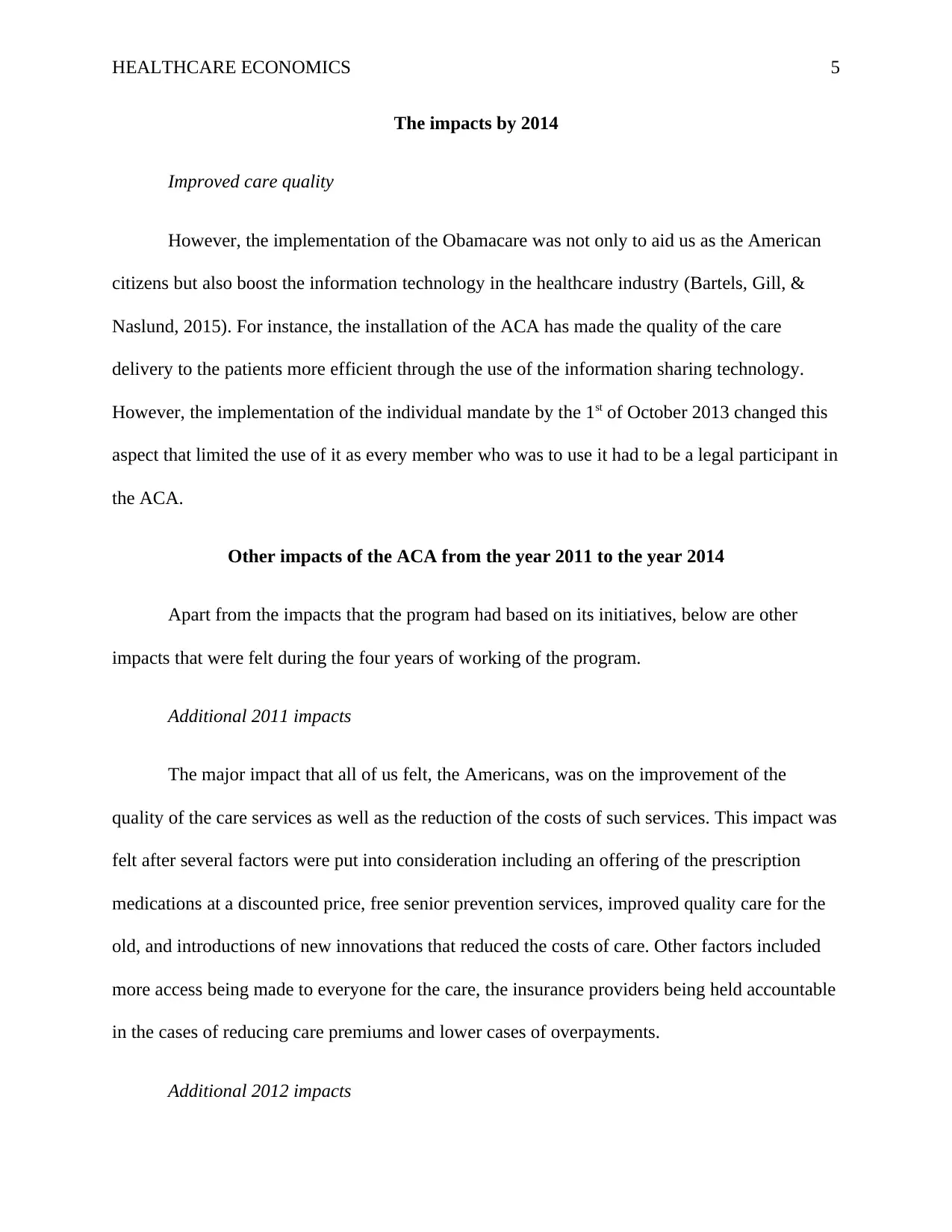
HEALTHCARE ECONOMICS 5
The impacts by 2014
Improved care quality
However, the implementation of the Obamacare was not only to aid us as the American
citizens but also boost the information technology in the healthcare industry (Bartels, Gill, &
Naslund, 2015). For instance, the installation of the ACA has made the quality of the care
delivery to the patients more efficient through the use of the information sharing technology.
However, the implementation of the individual mandate by the 1st of October 2013 changed this
aspect that limited the use of it as every member who was to use it had to be a legal participant in
the ACA.
Other impacts of the ACA from the year 2011 to the year 2014
Apart from the impacts that the program had based on its initiatives, below are other
impacts that were felt during the four years of working of the program.
Additional 2011 impacts
The major impact that all of us felt, the Americans, was on the improvement of the
quality of the care services as well as the reduction of the costs of such services. This impact was
felt after several factors were put into consideration including an offering of the prescription
medications at a discounted price, free senior prevention services, improved quality care for the
old, and introductions of new innovations that reduced the costs of care. Other factors included
more access being made to everyone for the care, the insurance providers being held accountable
in the cases of reducing care premiums and lower cases of overpayments.
Additional 2012 impacts
The impacts by 2014
Improved care quality
However, the implementation of the Obamacare was not only to aid us as the American
citizens but also boost the information technology in the healthcare industry (Bartels, Gill, &
Naslund, 2015). For instance, the installation of the ACA has made the quality of the care
delivery to the patients more efficient through the use of the information sharing technology.
However, the implementation of the individual mandate by the 1st of October 2013 changed this
aspect that limited the use of it as every member who was to use it had to be a legal participant in
the ACA.
Other impacts of the ACA from the year 2011 to the year 2014
Apart from the impacts that the program had based on its initiatives, below are other
impacts that were felt during the four years of working of the program.
Additional 2011 impacts
The major impact that all of us felt, the Americans, was on the improvement of the
quality of the care services as well as the reduction of the costs of such services. This impact was
felt after several factors were put into consideration including an offering of the prescription
medications at a discounted price, free senior prevention services, improved quality care for the
old, and introductions of new innovations that reduced the costs of care. Other factors included
more access being made to everyone for the care, the insurance providers being held accountable
in the cases of reducing care premiums and lower cases of overpayments.
Additional 2012 impacts
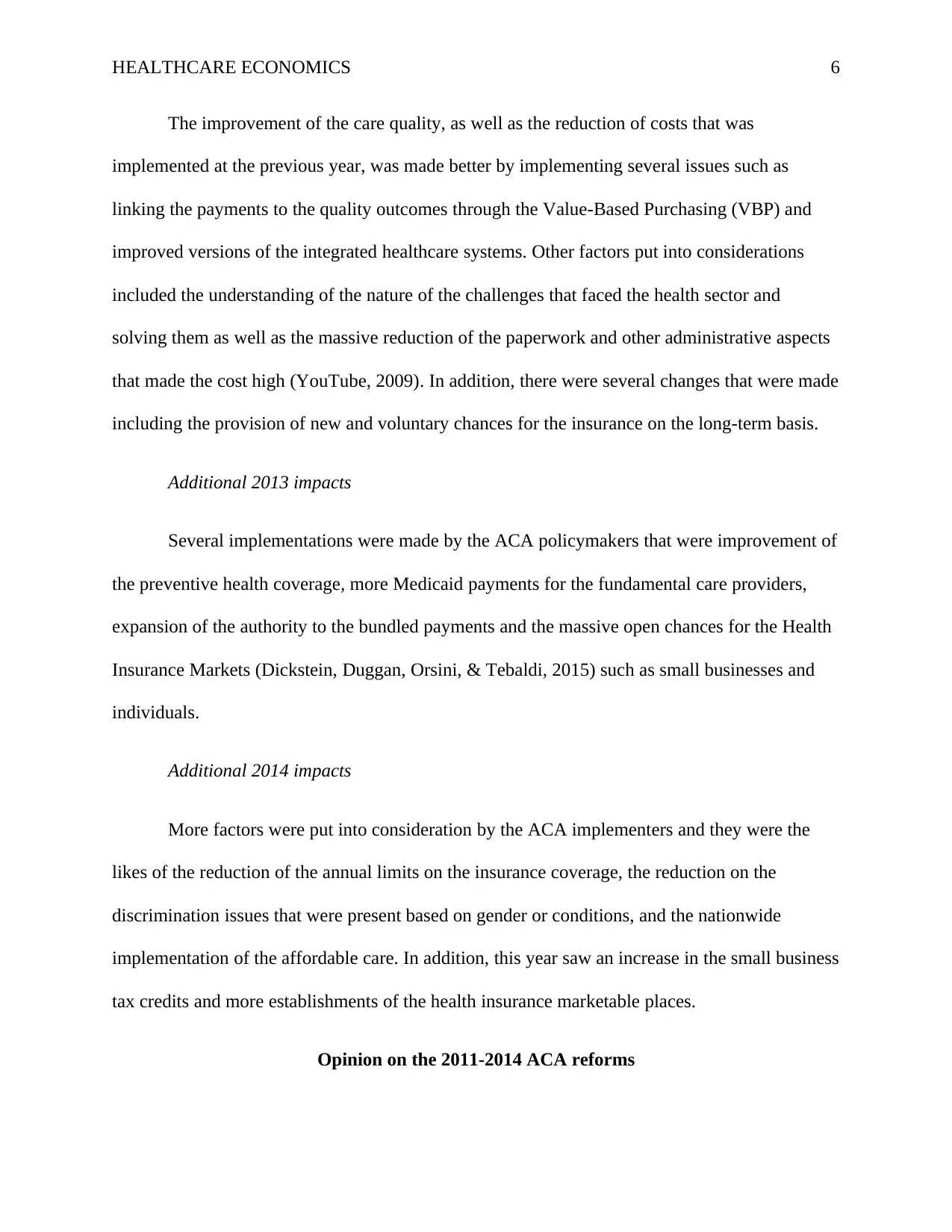
HEALTHCARE ECONOMICS 6
The improvement of the care quality, as well as the reduction of costs that was
implemented at the previous year, was made better by implementing several issues such as
linking the payments to the quality outcomes through the Value-Based Purchasing (VBP) and
improved versions of the integrated healthcare systems. Other factors put into considerations
included the understanding of the nature of the challenges that faced the health sector and
solving them as well as the massive reduction of the paperwork and other administrative aspects
that made the cost high (YouTube, 2009). In addition, there were several changes that were made
including the provision of new and voluntary chances for the insurance on the long-term basis.
Additional 2013 impacts
Several implementations were made by the ACA policymakers that were improvement of
the preventive health coverage, more Medicaid payments for the fundamental care providers,
expansion of the authority to the bundled payments and the massive open chances for the Health
Insurance Markets (Dickstein, Duggan, Orsini, & Tebaldi, 2015) such as small businesses and
individuals.
Additional 2014 impacts
More factors were put into consideration by the ACA implementers and they were the
likes of the reduction of the annual limits on the insurance coverage, the reduction on the
discrimination issues that were present based on gender or conditions, and the nationwide
implementation of the affordable care. In addition, this year saw an increase in the small business
tax credits and more establishments of the health insurance marketable places.
Opinion on the 2011-2014 ACA reforms
The improvement of the care quality, as well as the reduction of costs that was
implemented at the previous year, was made better by implementing several issues such as
linking the payments to the quality outcomes through the Value-Based Purchasing (VBP) and
improved versions of the integrated healthcare systems. Other factors put into considerations
included the understanding of the nature of the challenges that faced the health sector and
solving them as well as the massive reduction of the paperwork and other administrative aspects
that made the cost high (YouTube, 2009). In addition, there were several changes that were made
including the provision of new and voluntary chances for the insurance on the long-term basis.
Additional 2013 impacts
Several implementations were made by the ACA policymakers that were improvement of
the preventive health coverage, more Medicaid payments for the fundamental care providers,
expansion of the authority to the bundled payments and the massive open chances for the Health
Insurance Markets (Dickstein, Duggan, Orsini, & Tebaldi, 2015) such as small businesses and
individuals.
Additional 2014 impacts
More factors were put into consideration by the ACA implementers and they were the
likes of the reduction of the annual limits on the insurance coverage, the reduction on the
discrimination issues that were present based on gender or conditions, and the nationwide
implementation of the affordable care. In addition, this year saw an increase in the small business
tax credits and more establishments of the health insurance marketable places.
Opinion on the 2011-2014 ACA reforms
⊘ This is a preview!⊘
Do you want full access?
Subscribe today to unlock all pages.

Trusted by 1+ million students worldwide
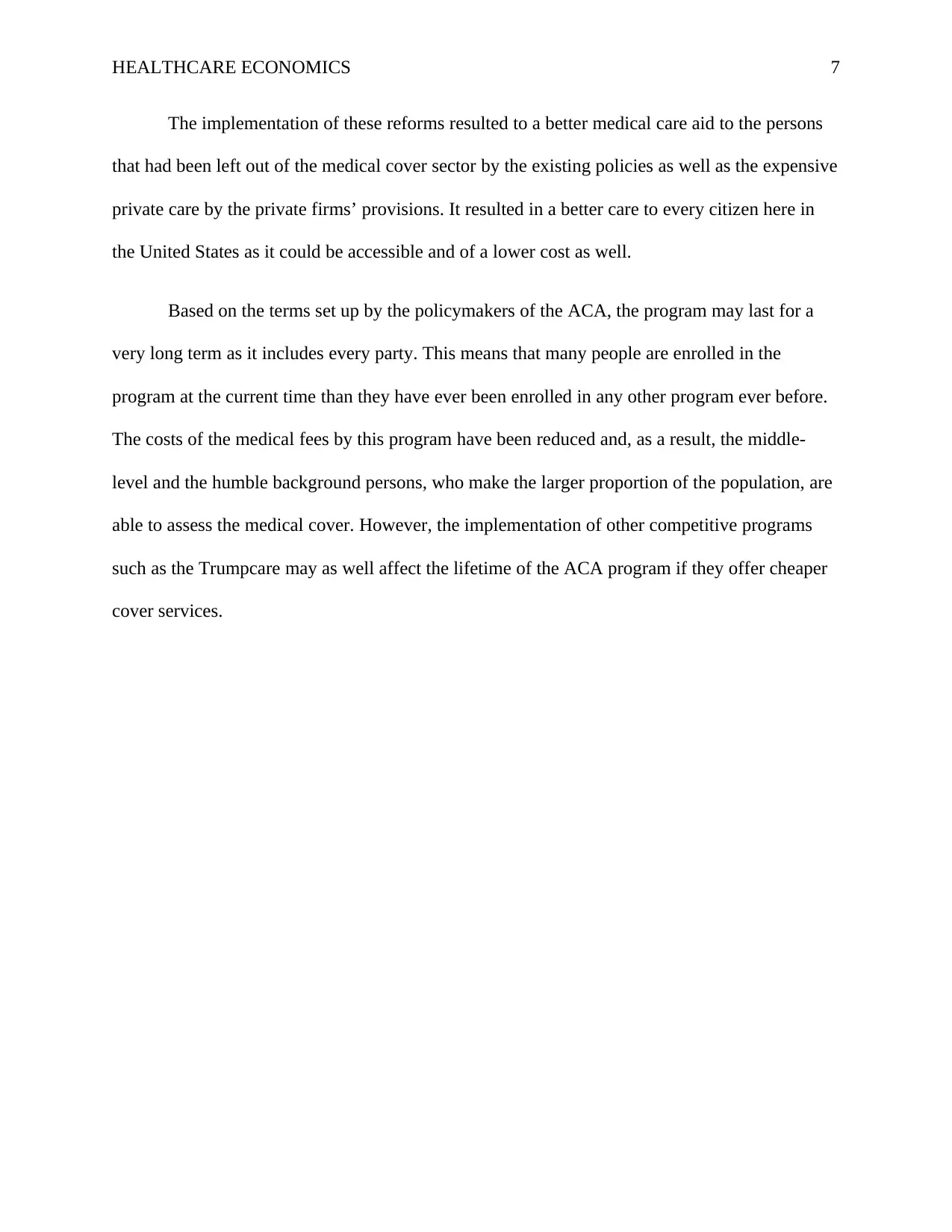
HEALTHCARE ECONOMICS 7
The implementation of these reforms resulted to a better medical care aid to the persons
that had been left out of the medical cover sector by the existing policies as well as the expensive
private care by the private firms’ provisions. It resulted in a better care to every citizen here in
the United States as it could be accessible and of a lower cost as well.
Based on the terms set up by the policymakers of the ACA, the program may last for a
very long term as it includes every party. This means that many people are enrolled in the
program at the current time than they have ever been enrolled in any other program ever before.
The costs of the medical fees by this program have been reduced and, as a result, the middle-
level and the humble background persons, who make the larger proportion of the population, are
able to assess the medical cover. However, the implementation of other competitive programs
such as the Trumpcare may as well affect the lifetime of the ACA program if they offer cheaper
cover services.
The implementation of these reforms resulted to a better medical care aid to the persons
that had been left out of the medical cover sector by the existing policies as well as the expensive
private care by the private firms’ provisions. It resulted in a better care to every citizen here in
the United States as it could be accessible and of a lower cost as well.
Based on the terms set up by the policymakers of the ACA, the program may last for a
very long term as it includes every party. This means that many people are enrolled in the
program at the current time than they have ever been enrolled in any other program ever before.
The costs of the medical fees by this program have been reduced and, as a result, the middle-
level and the humble background persons, who make the larger proportion of the population, are
able to assess the medical cover. However, the implementation of other competitive programs
such as the Trumpcare may as well affect the lifetime of the ACA program if they offer cheaper
cover services.
Paraphrase This Document
Need a fresh take? Get an instant paraphrase of this document with our AI Paraphraser
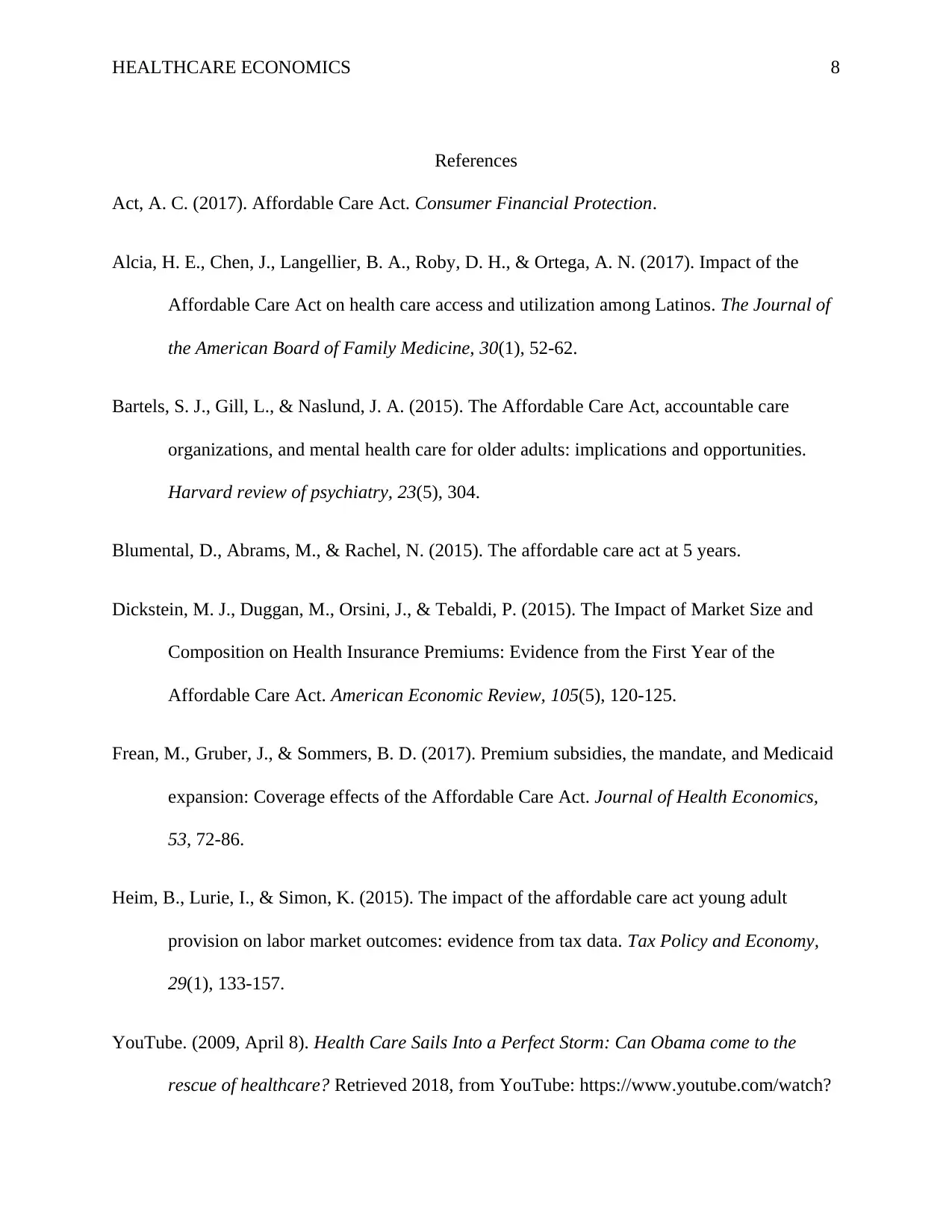
HEALTHCARE ECONOMICS 8
References
Act, A. C. (2017). Affordable Care Act. Consumer Financial Protection.
Alcia, H. E., Chen, J., Langellier, B. A., Roby, D. H., & Ortega, A. N. (2017). Impact of the
Affordable Care Act on health care access and utilization among Latinos. The Journal of
the American Board of Family Medicine, 30(1), 52-62.
Bartels, S. J., Gill, L., & Naslund, J. A. (2015). The Affordable Care Act, accountable care
organizations, and mental health care for older adults: implications and opportunities.
Harvard review of psychiatry, 23(5), 304.
Blumental, D., Abrams, M., & Rachel, N. (2015). The affordable care act at 5 years.
Dickstein, M. J., Duggan, M., Orsini, J., & Tebaldi, P. (2015). The Impact of Market Size and
Composition on Health Insurance Premiums: Evidence from the First Year of the
Affordable Care Act. American Economic Review, 105(5), 120-125.
Frean, M., Gruber, J., & Sommers, B. D. (2017). Premium subsidies, the mandate, and Medicaid
expansion: Coverage effects of the Affordable Care Act. Journal of Health Economics,
53, 72-86.
Heim, B., Lurie, I., & Simon, K. (2015). The impact of the affordable care act young adult
provision on labor market outcomes: evidence from tax data. Tax Policy and Economy,
29(1), 133-157.
YouTube. (2009, April 8). Health Care Sails Into a Perfect Storm: Can Obama come to the
rescue of healthcare? Retrieved 2018, from YouTube: https://www.youtube.com/watch?
References
Act, A. C. (2017). Affordable Care Act. Consumer Financial Protection.
Alcia, H. E., Chen, J., Langellier, B. A., Roby, D. H., & Ortega, A. N. (2017). Impact of the
Affordable Care Act on health care access and utilization among Latinos. The Journal of
the American Board of Family Medicine, 30(1), 52-62.
Bartels, S. J., Gill, L., & Naslund, J. A. (2015). The Affordable Care Act, accountable care
organizations, and mental health care for older adults: implications and opportunities.
Harvard review of psychiatry, 23(5), 304.
Blumental, D., Abrams, M., & Rachel, N. (2015). The affordable care act at 5 years.
Dickstein, M. J., Duggan, M., Orsini, J., & Tebaldi, P. (2015). The Impact of Market Size and
Composition on Health Insurance Premiums: Evidence from the First Year of the
Affordable Care Act. American Economic Review, 105(5), 120-125.
Frean, M., Gruber, J., & Sommers, B. D. (2017). Premium subsidies, the mandate, and Medicaid
expansion: Coverage effects of the Affordable Care Act. Journal of Health Economics,
53, 72-86.
Heim, B., Lurie, I., & Simon, K. (2015). The impact of the affordable care act young adult
provision on labor market outcomes: evidence from tax data. Tax Policy and Economy,
29(1), 133-157.
YouTube. (2009, April 8). Health Care Sails Into a Perfect Storm: Can Obama come to the
rescue of healthcare? Retrieved 2018, from YouTube: https://www.youtube.com/watch?

HEALTHCARE ECONOMICS 9
v=KxkiWh60Otw
v=KxkiWh60Otw
⊘ This is a preview!⊘
Do you want full access?
Subscribe today to unlock all pages.

Trusted by 1+ million students worldwide
1 out of 9
Related Documents
Your All-in-One AI-Powered Toolkit for Academic Success.
+13062052269
info@desklib.com
Available 24*7 on WhatsApp / Email
![[object Object]](/_next/static/media/star-bottom.7253800d.svg)
Unlock your academic potential
Copyright © 2020–2025 A2Z Services. All Rights Reserved. Developed and managed by ZUCOL.




